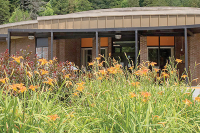WNC duo star on reality TV show
 Lights, camera … Haywood County?
Lights, camera … Haywood County?
During the past two years, a local reality show has become a phenomenon that’s being broadcast into homes across the country and beyond. The program is “Hillbilly Blood: A Hardscrabble Life,” and it features Western North Carolina outdoor survival experts Spencer Bolejack and Eugene Runkis.
“There’s a lot of perplexity in ‘Hillbilly Blood,’” Bolejack said. “On one hand, it can be silly and entertaining, and on the other is a lot of valid information on how to survive and thrive in the outdoors.”
With the second season currently hitting the airwaves, the premise of the program follows Bolejack, 36, and Runkis, 44, around the woods of Haywood County, where they cross paths with skilled craftsman and figure out planned scenarios or get out of surprising situations.
“We concentrate on community, fellowship with neighbors, helping people out when you’re supposed to, which are all Southern Appalachian values,” Runkis said. “Spencer and I come up with and build ideas, figure out storylines and invite guests into the show.”
Related Items
Each episode features another member of the local community, ranging from a blacksmith to moonshiner to sawmill operator. One day, they’re making a canoe out of a burned out log; the next, they’re creating electricity with firewood or finding the ideal method to distill moonshine.
“With this show, we want people to see that hillbillies are intelligent people and not necessarily stupid, grass-chewing people,” Runkis said. “If somebody calls me a hillbilly, I look at it as a badge of honor because they’re telling me I’m intelligent.”
Taking the outdoors online
The show all started two years ago when the duo, who didn’t know each other previously, were approached by the television channel 3net, which is a 3D station owned by the Discovery Channel.
“When we first did this, there was no other 3D show like ours,” Runkis said. “It’s a run and gun camera operation where you get 3D moments like when I’m chopping wood and a chip flies ‘out of the screen.’”
After a successful first season, the program moved up the ladder to the Destination America channel. As the notoriety and success began to snowball, so did the exposure with episodes now airing on the Discovery Channel to a lot of viewer curiosity.
“Honestly, I think the show is happening on some deep level that people are able to perceive, where once they get past the humor you can get into things about community friendship and start to see lessons within lessons,” Bolejack said.
Before they became television stars, both men had found Internet success during the past several years by posting survival videos on YouTube to millions of views and thousands of subscribers. Bolejack (under the online handle “WindRider707”) would post clips of his martial arts and outdoor skills, while Runkis (“TrapperJackSurvival”) uploaded dozens of videos showcasing his survival techniques.
Through his videos and Land of the Sky Wilderness School summer camps he conducts throughout the region, Bolejack, a resident of Bethel, was soon contacted by the television network about doing a series. It would be another year of talks before Runkis, hailing from Little Canada in Jackson County, was brought in as the last piece of the puzzle.
“The network found my videos, liked what I was saying and contacted me to see if I wanted to do a series,” Runkis chuckled. “I really didn’t know what to think about the whole thing. But, I stuck my neck out and told them I’d participate.”
With the plans in motion, Runkis had one last obstacle to overcome, which was to demonstrate to Superfine Films — the Manhattan-based production company behind the show — just how good his outdoor skills really were. For his presentation, Runkis made a shotgun out of part of a princess tree. He hollowed out a branch, stuffed it with gunpowder and shells, and lit the fuse to a successful blast. With that, Superfine had found their perfect co-star for Bolejack.
Into the wild
An 11th generation North Carolinian, Bolejack was raised on a tobacco farm, the family business, in Pilot Mountain. After the farm went under, he and his parents relocated to the forest outside of Asheville, where they lived off the land and enjoyed the fruits of not only their labor, but also of the natural beauty encapsulating them.
“I was a Boy Scout and an only child, so being the only child in a family that doesn’t buy a lot of things, you get outside and do things,” he said. “My father would always take me into the mountains. It was hard for me to stay focused in the classroom because I liked being outdoors too much.”
Those academic hardships put Bolejack at odds with the school. He was soon placed into an outdoor survival program aimed at reaching troubled youth, helping them find their inner potential on missions and treks in the great outdoors.
“A kid with ADHD, they have this big turbine in their mind and not enough water to run it, so they create their own information, and that’s what causes problems,” he said. “But outside, the turbine starts to run correctly, and they quickly realize their value as a human being.”
After graduating from UNC-Asheville, Bolejack went into teaching, only to be let go a few years later due to budget constraints. While he was teaching, he held martial arts seminars and started up Land of the Sky. With his layoff came the opportunity to find a way to make his hobbies into a career. The classes grew in popularity, with Bolejack teaching anyone interested in learning the discipline, patience and humility of truly being one with your surroundings.
“There are a lot of similarities between martial arts and being in the wilderness,” he said. “It’s about being aware, being humble. You can get knocked down in martial arts as easy as you can in the woods.”
Heading South
Runkis got his first taste of the outdoors growing up on his grandfather’s 80-acre property in the isolated forests of the Upper Peninsula in Michigan. He joined the Boy Scouts and ran around the woods, learning the proper techniques in trapping and orienteering, all the while harboring an ever-growing appreciation for nature.
“We all participate in nature, the trees and all of the animals participate in it,” he said. “Everything has its place, and by just making use of everything you can find out there, wild plants and animals, you help the natural cogs of the machine function.”
As a teenager, Runkis relocated to Florida, where he began to apprentice as a carpenter. He built restaurants, churches and homes around the South, eventually finding his way to Western North Carolina, a place where he had family and soon came to adore after several trips to the area. After 14 years in Jackson County, he had grown as attached to the forest as a mature tree tucked away in the deep wilderness of Southern Appalachia.
“I was learning a lot about bush craft, where I was building log cabins using all the traditional pioneer methods, woodworking, splitting logs, healing logs,” he said. “I learned it all, and I enjoyed it as much back then as I do today. It’s a big part of what I teach.”
In 2008, he launched his “TrapperJackSurvival” channel (after a wilderness mentor in Michigan named Jack) channel on YouTube to great fanfare. The initial intent of the videos was to promote an outfitter store he had hoped to open in Florida. The store never really got off the ground, but the videos kept being made. It was an outlet that would soon prove worthwhile once television came knocking on his door.
“I’m always discovering something new,” he said. “The more you use the techniques, the more you learn from it.”
Roll camera
Throughout each of the 12 episodes of season two, Bolejack and Runkis bring on one person whose background provides the storyline of the program. Owner of Cheyenne’s Corner (located in the Bethel Grocery), Cheyenne Keener specializes in hunting and fishing supplies. Hillbilly Blood used his shop on a couple of episodes, where Keener became a character that helped the duo find what they needed for their next quest.
“I was pretty surprised that they wanted to a film a show here,” Keener laughed. “But, it all went pretty great, and I’ve made a lot of good friends with members of the production company over the two seasons.”
And though the series is meant to be educational entertainment, something to be taken with a grain of salt and hearty laugh, controversy has risen with local residents and viewers alike pointing out the falsity of the show, where at some plot points it seems that southern “hillbilly” stereotypes may be perpetuated.
“Everybody is going to have their own opinion, and there’s never going to be a time where everybody is in agreement,” Keener said. “It was something fun to do, and Spencer and Eugene never set out to do something that would offend people.”
“Everything that we show is almost always something we’ve done in real life,” Bolejack added. “In one episode, we were ‘lost in the woods,’ and I don’t feel disingenuous because it was staged. I lived in the woods for a very long time, and guided wilderness tours for most of my life. I’ve been in those situations, wandering through swamps, lost, hungry, scared, so to make a show about it doesn’t feel false to me at all.”
Brought on for three episodes, Caleb Burress was not only a character but also found work as a member of the build crew. Burress and his father were brought on as blacksmiths. Bolejack and Runkis came to fix a pigpen when their tomahawk broke, and the blacksmiths had to make another one to be able to complete the project.
“We had already slaughtered the pigs, so the production company had to rent a couple from Asheville,” Caleb smiled.
No stranger to the spotlight, Caleb had done a lot of community theatre and productions for his blacksmithing during the years. When brought on the show, he had to play coy, as if everything was a surprise. His band Soldier’s Heart, a Haywood County-based “down home porch and soul” group, performed for the season two finale.
“I acted like I showed up, was a character on the show, then built part of the stage as a member of the crew, then got up there and played on it,” he said. “If you’re looking for truth in television, you’re barking up the wrong tree.”
David Burnette, a skilled craftsman in many different trades known for his work at Cradle of Forestry, was incorporated into the program with his old-time functioning sawmill in Canton. Bolejack and Runkis had recovered a valuable white oak log submerged in a nearby lake. They came to Burnette to get the log cut and see what it was worth.
While the log was getting cut, the belt on the machine snapped and the duo came to the rescue by rigging a toe strap in place of the belt, thus kicking the saw back into gear.
“Hollywood puts its spin on it to get people to watch. If it was something that was going to make fun of mountain people, I wouldn’t have done it,” Burnette said.
So why does the viewing public have such a fascination with Hillbilly Blood?
“My daddy always said some people today forgot how to live, people have lost their way and are searching for something,” Burnette said. “People living here in the mountains could have lived anywhere, but we stayed here and are happy with what we have, and a lot of people don’t seem to understand that mindset.”
Onward and upward
With season two expected to wrap up on-air in the coming weeks, plans are already in the works for the production to return to Haywood County for season three filming this summer.
“I do take it in stride, and I don’t take it to seriously,” Bolejack said. “There’s both criticism and praise for our characters, and I’m just me and try to stay removed from that to stay sane.”
Runkis looks forward to “upping the ante” in story concepts and characters involved. He’s excited about doing bigger builds and being able to share even more special experiences one can cross paths with in these majestic mountains.
“This place is a gem and people here live by older values,” he said. “The communities here are like they were a hundred years ago — nothing changes, nothing goes unused, and nothing gets wasted.”
Though the show is scripted, and many of the scenarios staged in order to move the filming process and viewer interest along, what remains at the end of the day are real life people with intricate skills and talents, living in Southern Appalachian communities as unique as the characters themselves.
“It’s about using what’s around you and learning to become humble about it; it’s about feeling alive while building and creating,” he said. “We’re not guaranteed a lot of things we take for granted, and when you learn to build a fire yourself, when you learn the plants around you, then you learn to appreciate nature more, and that’s empowering.”
Editor’s Note: Superfine Films was contacted by The Smoky Mountain News for comments on this story but had not responded by presstime.









